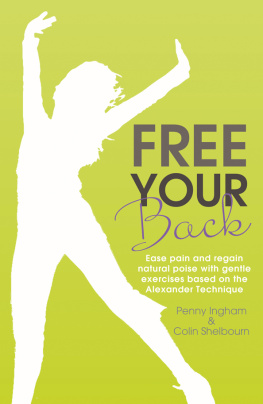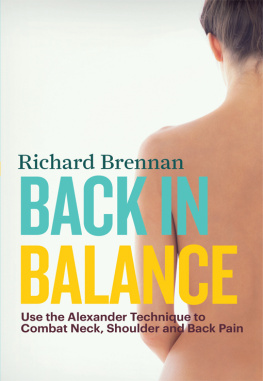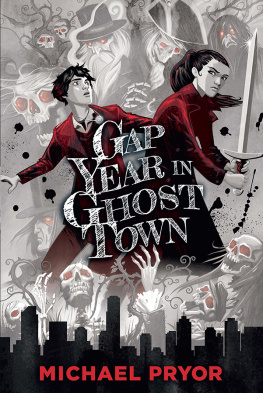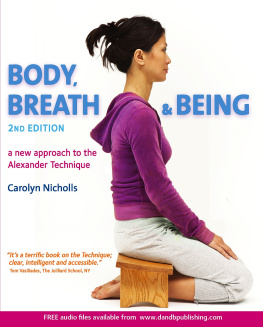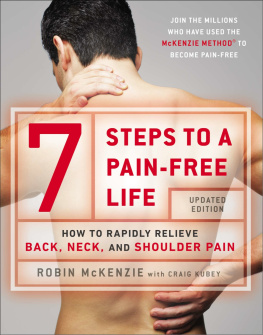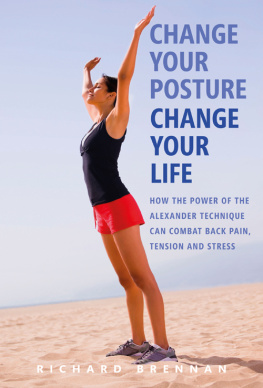

FREE YOUR BACK
First published as THE BUSY BODY by Summersdale Publishers Ltd, 2002
Published again as THE WELL-TUNED BODY in 2007
This edition copyright Penny Ingham and Colin Shelbourn 2013
The rights of Penny Ingham and Colin Shelbourn to be identified as the authors of this work have been asserted in accordance with sections 77 and 78 of the Copyright, Designs and Patents Act 1988.
All rights reserved.
Condition of Sale
This book is sold subject to the condition that it shall not, by way of trade or otherwise, be lent, re-sold, hired out or otherwise circulated in any form of binding or cover other than that in which it is published and without a similar condition including this condition being imposed on the subsequent purchaser.
Summersdale Publishers Ltd
46 West Street
Chichester
West Sussex
PO19 1RP
UK
www.summersdale.com
Printed and bound in Great Britain
ISBN: 978-0-85765-863-0
Substantial discounts on bulk quantities of Summersdale books are available to corporations, professional associations and other organisations. For details contact Nicky Douglas by telephone: +44 (0) 1243 756902, fax: +44 (0) 1243 786300 or email: nicky@summersdale.com.
To Russell and Polly,
for giving me direction (PI)
To Mary, onward and upward (CS)
INTRODUCTION
How are you holding this book? Is your chin jutting out? Head pulled back? Shoulders hunched? If you are standing, is all the weight on one leg? How are your hips? Hitched to one side? Is your lower back tight?

If you are sitting, are you arching your back or slumping in the chair? And by the way, how is your breathing?

Do you suffer from backache, tiredness, stiffness in the joints, digestive problems, lack of energy, shortness of breath, onset of RSI (repetitive strain injury), irritability or low self-esteem? If you have answered yes to some or all of these questions, you need Free Your Back.
The way that we habitually stand, sit and move can cause all of the above symptoms. Few of us have the alert, easy posture we had as children. Over the years we have acquired damaging postural habits which incorporate and reinforce the strain and tension of everyday living. But because we have learnt these habits, we can unlearn them.
Difficult or impossible though this seems, one remarkable man, F. Matthias Alexander, did just that. Alexander (1869 1955) was an Australian actor who developed a persistent vocal problem. Acutely observant, he set out to identify the cause for himself. He noticed that whenever he prepared to speak he became tense. Anyone might observe that in themselves and in others in a general way, but Alexander noticed particular details. Using mirrors, he saw himself pulling back his head, raising his chest and becoming shorter in stature as he prepared to speak. He further observed that, to a greater or lesser degree, this very negative pattern was present in many everyday actions, and that most of us carry these patterns of tension in our bodies until they produce pain and impaired movement. Of course, observing is not enough. At first he tried to make his body do what he wanted but this only created more tension. Realising this, he set about creating a technique for the re-education of his body, essentially a programme of consciously noticing and inhibiting habitual responses, and directing his body to a much more natural and poised way of being. He went on to teach his methods to others and the Alexander Technique is now taught worldwide.
HOW TO USE THIS BOOK
This book does not set out to teach the Alexander Technique (for that you would need to have lessons with a qualified teacher) but it is based on Alexanders principles. It is important that you should read Chapters before going on to other sections. These chapters form the foundation of the book and are fundamental to understanding later chapters. Begin with these and then you are ready to dip into any of the remaining chapters in or out of sequence, with the exception of Chapter 16, which should be read when you have looked at the book as a whole. Each chapter can be used as a self-contained piece of work, but your understanding will build up chapter by chapter.
Appendix 1 Body Map is also essential if you want to successfully navigate round your body.
Each chapter contains five sections: The Problem, The Exercises, The Principle, Posture Post-it and Reorganise Your Life.
THE PROBLEM
An unwelcome symptom, such as backache, is your body giving you useful feedback. Listen to it. The aches, pains and stiffness may well be the result of something you are doing to yourself. Over the years, you may have acquired damaging postural habits or methods of working and moving, which put unnecessary strain on your body. But, if you are doing harm to yourself, you can learn to undo it. What you need is this book and a little insight, patience and perseverance.
It is important to realise that body problems are interrelated. That stiffness in your fingers, for example, may be caused by the way you sit. The symptoms listed in this section are a rough indicator of what might be going wrong; all the chapters in the book will be beneficial, even if you think you need to address only one particular problem.
THE EXERCISES
These are quite unlike conventional keep-fit exercises. They are habit breakers. They require mental rather than physical effort. They are designed to examine and remedy the tense and over-effortful way in which you have been making everyday actions, and to encourage your body to revert to its natural, tension-free state. Take your time over each exercise if you do it too quickly, your muscles will take over and repeat the old, habitual way of doing things.
Throughout this book, we use words and images that help you make less effort. For example, we say: Let your elbows drop to your sides; Allow your shoulders to widen; Think of a string taking the crown of your head upwards. All of these phrases help you to naturally adopt these ideas, which is the very opposite of forcing the body into a good posture.
When you attempt the exercises, do so with a positive and interested attitude. The quality of your attention is a key factor in the effectiveness of each exercise. If you perform them quickly in a lets-get-this-done sort of way, your body will miss the point. Staying with the process can be difficult at first. If you find that your mind is elsewhere, find another time when you are in a more receptive mood. Work on these exercises when you feel you can give them your full attention and then you will be making real changes.
Remember that just as you acquired damaging postural habits by repeating the same thing over and over again, so you need to unlearn the habits by repeating the exercises. Like skilled craftsmen or musicians, you never stop practising and continue to work on yourself.
THE PRINCIPLE
In this section we explain more about why and how you might have acquired a particular problem, and the relevance of the exercises. It puts the work you are doing into a useful context. You will find it helpful to read these sections along with a glance at the Body Map (page 182).
Next page
